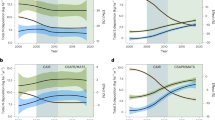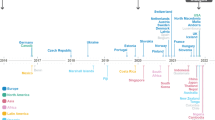Abstract
Air pollution abatement strategies for controlling nitrogen dioxide, sulfur dioxide, and ozone emissions in the United States focus on a ‘standards-based’ approach. This approach places limits on air pollution by maintaining a baseline value for air quality, no matter what the ecosystem can or cannot withstand. In this paper, we present example critical levels maps for the conterminous U.S. developed using the ‘effects-based’ mapping approach as defined by the United Nations Economic Commission for Europe's Convention on Long-Range Transboundary Air Pollution, Task Force on Mapping. This approach emphasizes the pollution level or load capacity an ecosystem can accommodate before degradation occurs, and allows for analysis of cumulative effects. We present the first stage of an analysis that reports the distribution of exceedances of critial levels for NO2, SO2, and O3 in sensitive forest, crop, and natural vegetation ecosystems in the contiguous United States. We conclude that extrapolation to surrounding geographic areas requires the analysis of diverse and compounding factors that preclude simple extrapolation methods. Pollutant data depicted in this analysis is limited to locationally specific data, and would be enhanced by utilizing spatial statistics, along with converging associated anthropogenic and climatological factors. Values used for critical levels were derived from current scientific knowledge. While not intended to be a definitive value, adjustments will occur as the scientific community gains new insight to pollutant/receptor relationships. We recommend future analysis to include a refinement of sensitive receptor data coverages and to report relative proportions of exceedances at varying grid scales.
Similar content being viewed by others
References
Burrough, P. A.: 1986, Principles of Geographical Information Systems For Land Resource Assessment, Oxford Science Publications, Monographs on Soil and Resources, No. 12, London, England.
Chadwick, M. J. and Kuylenstierna, J. C. I.: 1990, The Relative Sensitivity of Ecosystems in Europe to Acidic Depositions, Stockholm Environment Institute, Stockholm, Sweden.
Clean Air Act: 1970, U.S. Government Printing Office, Washington, DC.
Clean Air Act Amendments: 1990, S. 1630. U.S. Government Printing Office, Washington, DC.
Cressie, Noel A. C.: 1991, Statistics for Spatial Data, John Wiley & Sons, Inc., New York, NY.
ESRI (Environmental Systems Research Institute): 1989, ARC/INFO Volume 1 Users Guide, ESRI, Inc., Redlands, CA.
Gallant, A. L. Whittier, T. R. Larsen, D. P. Omernik, J. M., and Hughes, R. M.: 1989, Regionalization As A Tool For Managing Environmental Data, EPA/600/3-89/060, Environmental Research Laboratory, Corvallis, OR.
Goebel, J. J. and Dorsch, R. K.: 1986, National Resource Inventory: A Guide for Users of 1982 NRI Data Files, U.S. Department of Agriculture, Soil Conservation Service, Washington, DC.
Kalkstein, L. S. and Corrigan, P.: 1986, Annals of the Association of American Geographers 76, 381.
Lam, N. S.: 1983, Spatial Interpolation Methods: A Review, The American Cartographer, 10–2, p. 129–149.
Lee, E. H. Tingey, D. T. and Hogsett, W. E.: 1991, ‘Adjusting Ambient Ozone Air Quality Indicators for Missing Values’, 1991 Proceedings of the Business and Economics Section, American Statistical Association, Alexandria. VA, pp. 198–203.
Lefohn, A. S. Knudsen, H. P. Logan, J. A. Simpson, J. and Bhumralkar, C.: 1987, Journal of Air Pollution Control Association 37, 595.
National Air Data Branch: 1987, AIRS User Guide Volume I–VII. Office of Air Quality Planning and Standards, Monitoring and Data Analysis Branch, U.S. Environmental Protection Agency, Washington, DC.
Personal Communication, National Delegates to the Task Force on Mapping's Training Session on Mapping, Bilthoven, The Netherlands, June 25–27, 1990.
Robinson, V. B. and Frank, A. V.: 1985, ‘About Different Kinds of Uncertainty in Collections of Spatial Data’ Auto-Carto 7 Proceedings, pp. 440–449.
Schere, K. L.: 1988, Environmental Science and Technology 22, 488.
Sperber, K. R.: 1987, Atmospheric Environment 21, 2629.
Swedish Ministry of Agriculture: 1982. Acidification Today and Tomorrow, Environment '82 Committee, Stockholm, Sweden.
Tabios, G. Q. and Sales, J. D.: 1985, Water Resources Bulletin 21, 365.
UN-ECE (United Nations Economic Commission for Europe): 1990, Draft Manual On Methodologies And Criteria For Mapping Critical Levels/Loads And Geographical Areas Where They Are Exceeded, Convention on Long-Range Transboundary Air Pollution, Task Force on Mapping, p. 98.
U. S. Department of Agriculture: 1969 U. S. Census of Agriculture, U.S. Government Printing Office, Washington, DC.
U. S. Department of Agriculture: 1974 U. S. Census of Agriculture, U.S. Government Printing Office, Washington, DC.
U. S. Department of Agriculture: 1979 U. S. Census of Agriculture, U.S. Government Printing Office, Washington, DC.
U.S./Canada Memorandum of Intent (MOI) on Transboundary Air Pollution: 1983, Work Group I, Impact Assessment. Final Report. Coordinating Committee of the MOI, Washington, DC.
U.S. Geological Survey, Department of the Interior: 1987, Digital Line Graphs from 1:2,000,000 Scale Maps — Data Users Guide 3. National Mapping Program Technical Instructions, Reston, VA.
U. S. Geological Survey, Department of the Interior: 1986, Federal Lands Map, The National Atlas of the United States of America, Reston, VA, pp. 272–273.
U. S. Geological Survey, Department of the Interior: 1986, Major Forest Types Map, The National Atlas of the United States of America, Reston, VA, pp. 154–155.
Author information
Authors and Affiliations
Additional information
The research described in this manuscript has been funded by the U.S. Environmental Protection Agency. This document was prepared at the EPA Environmental Research Laboratory in Corvallis, Oregon through contract # 68-C8-0006 to ManTech Environmental Technology Inc. It has been subjected to the Agency's peer and administrative review and approved for publication. Mention of trade names or commercial products does not constitute endorsement or recommendation for use.
Rights and permissions
About this article
Cite this article
Rosenbaum, B.J., Strickland, T.C. & Mcdowell, M.K. Mapping critical levels of ozone, sulfur dioxide and nitrogen dioxide for crops, forests and natural vegetation in the United States. Water Air Soil Pollut 74, 307–319 (1994). https://doi.org/10.1007/BF00479797
Received:
Accepted:
Issue Date:
DOI: https://doi.org/10.1007/BF00479797




